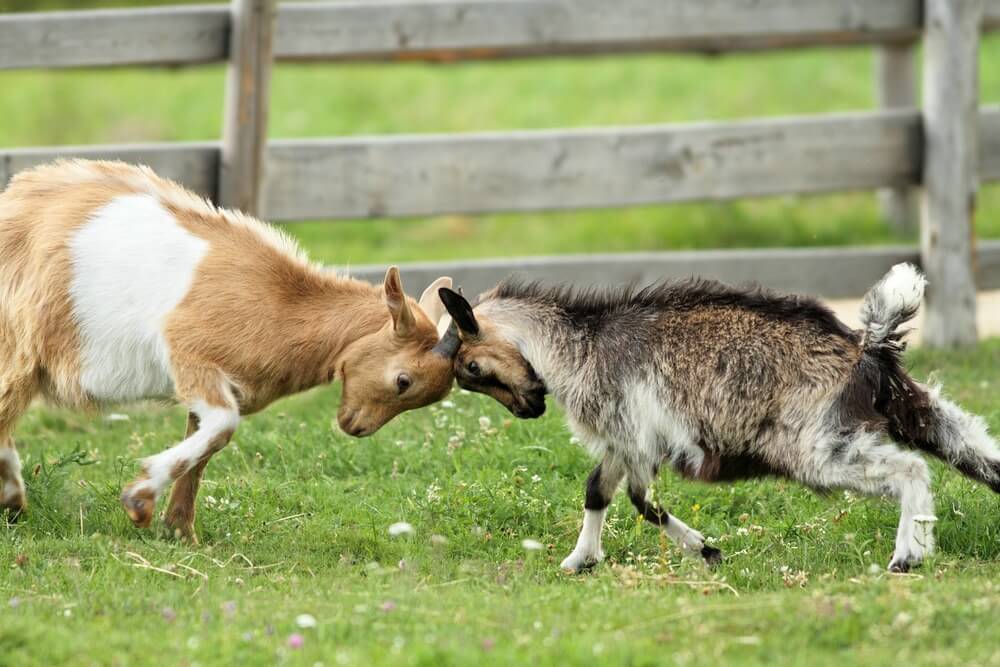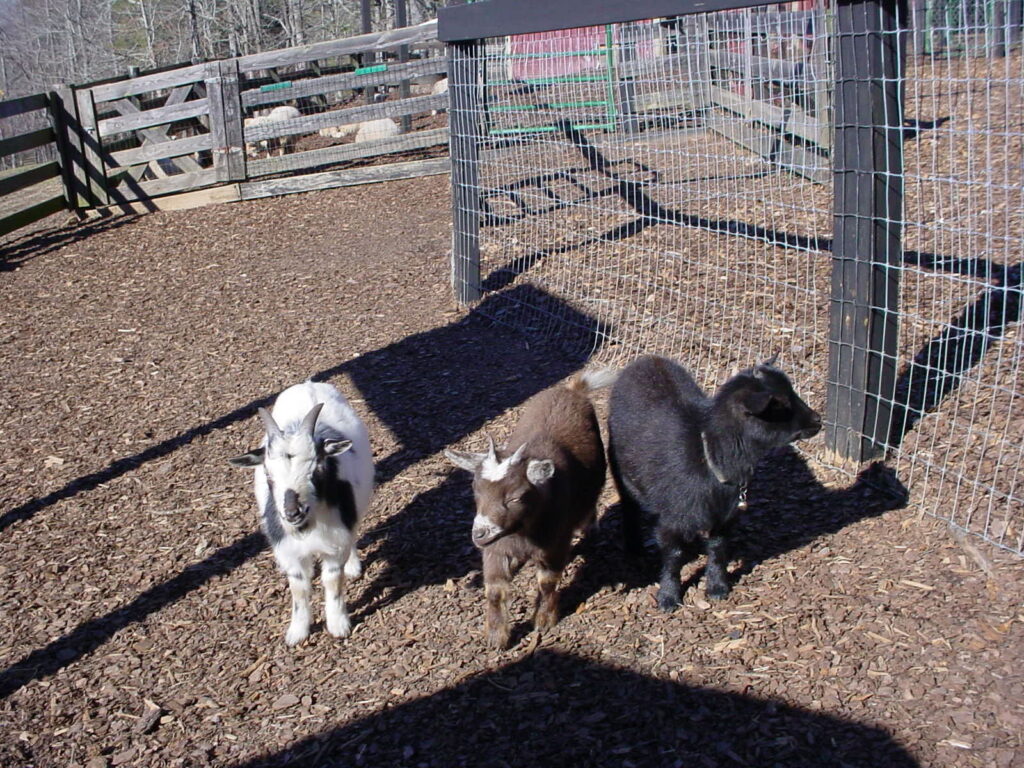Nigerian Dwarf goats are about half the height of a standard sized goat, yet bigger than a pygmy goat. A good size reference would be a medium sized dog such as a Golden Retriever. They typically weigh around 50 lbs, so if you need to pick up your goat to get them to go onto the milk stand, you can. That may be the voice of experience. Since the goats are smaller, fencing is easier as it doesn’t need to be as tall. A 4 foot fence is more than plenty to keep the goats where you’d like them to be, as long as it is tight and doesn’t provide “ramps” such as angled bracing.
If you don’t have a livestock trailer, then you are in luck. Nigerian Dwarf goats are very easy to haul. We have hauled our goats numerous times, in a large dog cage in the back of our minivan. Three Nigerian Dwarf goats easily fit in a large dog cage. We’ve hauled standard size goats that way, and while it’s doable to transport 1 goat in the back of the van, it’s a lot more difficult. One note of caution, only transport a buck in this manner if you have a fondness for that lovely “bucky” aroma. It will take weeks for that scent to get out of the van!
Once you’ve tasted goat’s milk from a Nigerian Dwarf goat, you will never want any other kind of goat milk again. The milk contains twice as much milk fat, sometimes more, than any other breed of goat with the exception of a pygmy goat. While pygmy goats are difficult to milk, fortunately Nigerian Dwarf goats are not. If you are intimidated by their small teats, a Henry Milker works quite well. Milking a Nigerian Dwarf goat is not more difficult than a milking a standard sized goat, but the technique is somewhat different. I milk both and find them to be equally easy to milk, it just takes practice.
Nigerian Dwarf goats produce less milk than a standard sized goat, around 1-2 quarts per day. Some may think that isn’t much, but quality over quantity, right? We are currently milking two Nigerian Dwarf goats and have an adequate supply of fresh milk for our family. In order to have enough to make yogurt and cheese, we do milk our standard sized goats along with the Nigerian Dwarf goats.
When people think of goats, they typically think that they’re naughty and up to no good. Sure, some goats have attitudes and they do like to climb if given the opportunity, but not all goats are naughty. Each breed of goat has their own “personality”. Nigerian Dwarf goats are very docile and sweet. Our girls are always looking for a good scratch on their back. They are not aggressive at all, which makes them great to have around children. Ever since our daughter was 4 years old, she has spent a lot of time out in the goat pen petting and talking to the goats. She loves it and so do the goats.








Most goats are seasonal breeders, meaning they only go into heat certain times of the year. Nigerian Dwarf goats go into heat every 21-28 days, all year long. This makes breeding much easier, as you don’t have a few month window to get your goats bred in. It also means that with careful planning, you can have goats at their peak milk supply twice a year. Plan for one goat to kid in October and the next goat to kid in April and you will have fresh milk year round! Keep in mind that we often milk a goat for a year straight (and likely could go longer), as long as their condition stays good and they continue to produce well.
Nigerian Dwarf goats are quiet! They do not call and cause a ruckus, even when they’re in heat. Sure, they do “talk” and make noises, but nothing compared to standard sized goats. For example, Lola our La Mancha, is very noisy and will loudly voice her opinion if anything isn’t quite up to her standards. Yes, apparently goats do have standards.
Another nice perk to owning a Nigerian Dwarf goat is that there are some cities that now allow you to have Nigerian Dwarf goats in town. Colorado Springs is one, and I’m sure there are more. There are specific requirements, like lot size and how many goats are allowed, so check your city’s regulations on what the guidelines are where you live.
Finally, there is one myth not unique to Nigerian Dwarf goats that just needs to be dispelled. Often people refer to “those nasty stinky goats” and say they could never drink milk from such a stinky animal. This is just completely wrong! If a doe goat stinks, there is a serious problem or they have just gotten back from a “date” with a buck. We definitely do keep our doe goats separate from bucks because the bucks certainly do have a rather peculiar odor. I actually find that cows have a lot more odor than our doe goats.
A miniature goat of balanced proportions and dairy conformation. The facial profile is straight or slightly concave, and ears medium length and erect. The coat is short to medium length. Eyes are occasionally blue. The male has a heavy beard.
Normally from 17 in. to 23.5 in. (for bucks) and 22.5 in. (for does).
Around 75 lb. (34 kg).
1–2 quarts/liters per day for up to 10 months. The milk is sweet and exceptionally high in butterfat (over 6%) and protein (average 3.9%), making it excellent for cheese and butter. Does usually breed in any season, so are sometimes bred three times over two years, leaving at least a six-month rest. Does rarely suffer from kidding problems. They make excellent mothers and can dry off naturally if required. These traits make them ideal for a moderate, year-round milk supply.
Generally gentle and calm, they are gregarious in nature and friendly when raised around people.
They are hardy and adapt to most climates and husbandry conditions, although they do require fencing that accounts for their small size and propensity to explore. Despite their small size, Nigerian Dwarf goats’ lifespan is comparable to that of standard-sized domestic goats. Their hardiness equips them to live for 15–20 years, if well cared for.

The original WAD foundation has high genetic diversity with a great variation in size, color, and other traits, including useful health traits. WAD individuals at range are often smaller than those in research centers and those exported to Europe and America. For example, adult weights of 40–75 lb. (18–34 kg) and heights of 15–22 inches (37–55 cm) have been recorded in Nigeria. The greater Nigerian Dwarf goats’ weight and size seen in America may be due to the genetic potential of the chosen foundation stock and selective breeding for production, combined with easier living conditions and more plentiful feed. On the other hand, selective breeding for cuteness could lead to increased miniaturization, which might impact health. For this reason, some registries impose a minimum size to discourage breeding to extremes.

Ready to take the next step in your goat’s training journey? Contact us today to schedule a consultation with one of our experienced trainers. We’ll discuss your goals, assess your goats’s current level of training, and develop a personalized training plan to help you achieve success.
Stay connected with nigerian dwarf goat sales on social media for the latest updates, news, and featured horses: